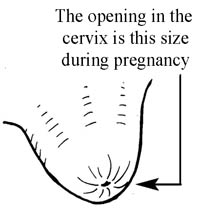1.3.1 First stage of labour

The first stage of labour is characterised by progressive opening of the cervix, which dilates enough to let the baby out of the uterus. For most of the pregnancy, nothing can get in or out of the cervix, because the tiny opening in it is plugged with mucus.
During pregnancy the cervix is long and firm, like a big toe (see Figure 1.1a), but the immediate effect of uterine contraction is to dilate the cervix and shorten the lower segment of the uterus, so the edges of the cervix are gradually drawn back and are taken up. This process is called effacement (Figure 1.1b and c).

The cervix then dilates (the diameter gradually increases) – this is known as cervical dilatation. Each time the uterus contracts, it pulls a little bit of the cervix up and open. Between contractions, the cervix relaxes. The first stage is divided into two phases: the latent and the active phase, based on how much the cervix has dilated.
Latent phase
The latent phase is the period between the start of regular rhythmic contractions up to cervical dilatation of 4 cm. During this phase, contractions may or may not be very painful, and the cervix dilates very slowly. The latent phase ends when the rate at which the cervix is dilating speeds up (it dilates more quickly). This signals the start of the active phase.
Active phase

The active phase is said to be when the cervix is greater than 4 cm dilated. Contractions become regular, frequent and usually painful. The rate of cervical dilation becomes faster and it may increase in diameter by as much as 1.2 to 1.5 cm per hour, but the minimum dilation rate should be at least 1 cm per hour. You should start to plot data on the partograph at this stage, as you will learn to do in Study Session 4 of this Module.
Cervical dilatation continues until the cervix is completely open: a diameter of 10 cm is called fully dilated. This is wide enough for the baby to pass through (Figure 1.2). At this diameter, you would not feel the cervix over the fetal head when you make a vaginal examination with your gloved fingers. (We will describe how to do this later in this Module and you will be shown how to do it in your practical training sessions.)

1.3 Stages of labour
